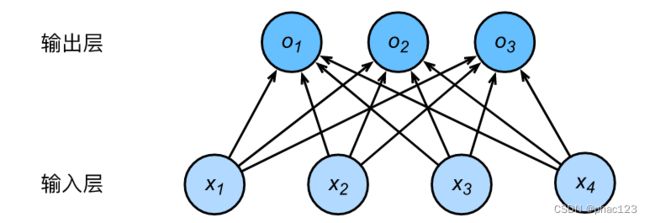Pytorch手动实现softmax回归
文章目录
- 简述
- 理论基础
-
- 回归
- softmax
- 损失函数
- 读取数据
- 初始化模型参数
- 实现softmax运算
- 定义模型
- 定义损失函数
- 计算分类准确率
- 训练模型
- 预测
- 整体代码
-
- d2lzh_pytorch.py
- main.py
简述
这次,将会使用到Fashion-MNIST数据集和操作
理论基础
回归
假设有输入的特征数有4个,分类的标签有3个.则回归方程为:
o 1 = x 1 w 11 + x 2 w 21 + x 3 w 31 + x 4 w 41 + b 1 o_1=x_1w_{11}+x_2w{21}+x_3w_{31}+x_4w_{41}+b_1 o1=x1w11+x2w21+x3w31+x4w41+b1
o 2 = x 1 w 12 + x 2 w 22 + x 3 w 32 + x 4 w 42 + b 1 o_2=x_1w_{12}+x_2w{22}+x_3w_{32}+x_4w_{42}+b_1 o2=x1w12+x2w22+x3w32+x4w42+b1
o 3 = x 1 w 11 + x 2 w 21 + x 3 w 31 + x 4 w 43 + b 1 o_3=x_1w_{11}+x_2w{21}+x_3w_{31}+x_4w_{43}+b_1 o3=x1w11+x2w21+x3w31+x4w43+b1
softmax
这样会得 [ y 1 ′ , y 2 ′ , y 3 ′ ] [y_1^{'},y_2^{'},y_3^{'}] [y1′,y2′,y3′],哪个数字更大,就取哪个.表示该样本属于这个标签.通过softmax可以得到:

损失函数
读取数据
使用Fashion-MNIST数据集,并设置批量大小为256
batch_size = 256
train_iter, test_iter = d2l.load_data_fashion_mnist(batch_size)
初始化模型参数
型的输入向量的长度是 28×28=78428×28=784:该向量的每个元素对应图像中每个像素。由于图像有10个类别,单层神经网络输出层的输出个数为10,因此softmax回归的权重和偏差参数分别为784×10和1×101×10的矩阵
num_inputs = 784
num_outputs = 10
W = torch.tensor(np.random.normal(0, 0.01, (num_inputs, num_outputs)), dtype=torch.float)
b = torch.zeros(num_outputs, dtype=torch.float)
W.requires_grad_(requires_grad=True)
b.requires_grad_(requires_grad=True)
实现softmax运算
def softmax(X):
X_exp = X.exp()
partition = X_exp.sum(dim=1, keepdim=True)
return X_exp / partition # 这里应用了广播机制
定义模型
def net(X):
return softmax(torch.mm(X.view((-1, num_inputs)), W) + b)
定义损失函数
def cross_entropy(y_hat, y):
return - torch.log(y_hat.gather(1, y.view(-1, 1)))
计算分类准确率
def accuracy(y_hat, y):
return (y_hat.argmax(dim=1) == y).float().mean().item()
训练模型
'''训练模型'''
num_epochs, lr = 5, 0.1
d2l.train_ch3(net, train_iter, test_iter, cross_entropy, num_epochs, batch_size, [w, b], lr)
预测
X, y = iter(test_iter).next()
true_labels = d2l.get_fashion_mnist_labels(y.numpy())
pred_labels = d2l.get_fashion_mnist_labels(net(X).argmax(dim=1).numpy())
titles = [true + '\n' + pred for true, pred in zip(true_labels, pred_labels)]
d2l.show_fashion_mnist(X[0:9], titles[0:9])
整体代码
d2lzh_pytorch.py
import random
from IPython import display
import matplotlib.pyplot as plt
import torch
import torchvision
import torchvision.transforms as transforms
import matplotlib.pyplot as plt
import time
import sys
def use_svg_display():
# 用矢量图显示
display.set_matplotlib_formats('svg')
def set_figsize(figsize=(3.5, 2.5)):
use_svg_display()
# 设置图的尺寸
plt.rcParams['figure.figsize'] = figsize
'''给定batch_size, feature, labels,做数据的打乱并生成指定大小的数据集'''
def data_iter(batch_size, features, labels):
num_examples = len(features)
indices = list(range(num_examples))
random.shuffle(indices)
for i in range(0, num_examples, batch_size): #(start, staop, step)
j = torch.LongTensor(indices[i: min(i + batch_size, num_examples)]) #最后一次可能没有一个batch
yield features.index_select(0, j), labels.index_select(0, j)
'''定义线性回归的模型'''
def linreg(X, w, b):
return torch.mm(X, w) + b
'''定义线性回归的损失函数'''
def squared_loss(y_hat, y):
return (y_hat - y.view(y_hat.size())) ** 2 / 2
'''线性回归的优化算法 —— 小批量随机梯度下降法'''
def sgd(params, lr, batch_size):
for param in params:
param.data -= lr * param.grad / batch_size #这里使用的是param.data
'''MINIST,可以将数值标签转成相应的文本标签'''
def get_fashion_mnist_labels(labels):
text_labels = ['t-shirt', 'trouser', 'pullover', 'dress', 'coat',
'sandal', 'shirt', 'sneaker', 'bag', 'ankle boot']
return [text_labels[int(i)] for i in labels]
'''定义一个可以在一行里画出多张图像和对应标签的函数'''
def show_fashion_mnist(images, labels):
use_svg_display()
# 这里的_表示我们忽略(不使用)的变量
_, figs = plt.subplots(1, len(images), figsize=(12, 12))
for f, img, lbl in zip(figs, images, labels):
f.imshow(img.view((28, 28)).numpy())
f.set_title(lbl)
f.axes.get_xaxis().set_visible(False)
f.axes.get_yaxis().set_visible(False)
plt.show()
'''获取并读取Fashion-MNIST数据集;该函数将返回train_iter和test_iter两个变量'''
def load_data_fashion_mnist(batch_size):
mnist_train = torchvision.datasets.FashionMNIST(root='Datasets/FashionMNIST', train=True, download=True,
transform=transforms.ToTensor())
mnist_test = torchvision.datasets.FashionMNIST(root='Datasets/FashionMNIST', train=False, download=True,
transform=transforms.ToTensor())
if sys.platform.startswith('win'):
num_workers = 0 # 0表示不用额外的进程来加速读取数据
else:
num_workers = 4
train_iter = torch.utils.data.DataLoader(mnist_train, batch_size=batch_size, shuffle=True, num_workers=num_workers)
test_iter = torch.utils.data.DataLoader(mnist_test, batch_size=batch_size, shuffle=False, num_workers=num_workers)
return train_iter, test_iter
'''评估模型net在数据集data_iter的准确率'''
def evaluate_accuracy(data_iter, net):
acc_sum, n = 0.0, 0
for X, y in data_iter:
acc_sum += (net(X).argmax(dim=1) == y).float().sum().item()
n += y.shape[0]
return acc_sum / n
'''训练模型,softmax'''
def train_ch3(net, train_iter, test_iter, loss, num_epochs, batch_size, params=None, lr=None, optimizer=None):
for epoch in range(num_epochs):
train_l_sum, train_acc_sum, n = 0.0, 0.0, 0
for X, y in train_iter:
y_hat = net(X)
l = loss(y_hat, y).sum()
# 梯度清零
if optimizer is not None:
optimizer.zero_grad()
elif params is not None and params[0].grad is not None:
for param in params:
param.grad.data.zero_()
l.backward()
if optimizer is None:
sgd(params, lr, batch_size)
else:
optimizer.step()
train_l_sum += l.item()
train_acc_sum += (y_hat.argmax(dim=1) == y).sum().item()
n += y.shape[0]
test_acc = evaluate_accuracy(test_iter, net)
print('epoch %d, loss %.4f, train acc %.3f, test acc %.3f'
% (epoch + 1, train_l_sum / n, train_acc_sum / n, test_acc))
main.py
import torch
import torchvision
import numpy as np
import sys
sys.path.append("..") # 为了导入上层目录的d2lzh_pytorch
import d2lzh_pytorch as d2l
# 使用Fashion-MNIST数据集
'''获取和读取数据'''
batch_size = 256
train_iter, test_iter = d2l.load_data_fashion_mnist(batch_size)
'''初始化模型参数'''
num_inputs = 784
num_outputs = 10
w = torch.tensor(np.random.normal(0, 0.01, (num_inputs, num_outputs)), dtype=torch.float)
b = torch.zeros(num_outputs, dtype = torch.float)
w.requires_grad_(requires_grad = True)
b.requires_grad_(requires_grad = True)
'''softmax运算'''
def softmax(X):
X_exp = X.exp()
partition = X_exp.sum(dim=1, keepdim=True)
return X_exp/partition
'''定义模型'''
def net(X):
return softmax(torch.mm(X.view(-1, num_inputs), w) + b)
'''定义损失函数'''
def cross_entropy(y_hat, y):
return - torch.log(y_hat.gather(1, y.view(-1, 1)))
'''计算准确率'''
def accuracy(y_hat, y):
return (y.hat.argmax(dim=1) == y).float().mean().item()
'''训练模型'''
num_epochs, lr = 5, 0.1
d2l.train_ch3(net, train_iter, test_iter, cross_entropy, num_epochs, batch_size, [w, b], lr)
'''预测'''
X, y = iter(test_iter).next()
true_labels = d2l.get_fashion_mnist_labels(y.numpy())
pred_labels = d2l.get_fashion_mnist_labels(net(X).argmax(dim=1).numpy())
titles = [true + '\n' + pred for true, pred in zip(true_labels, pred_labels)]
d2l.show_fashion_mnist(X[0:9], titles[0:9])

